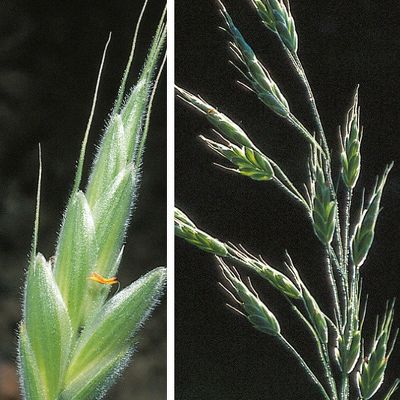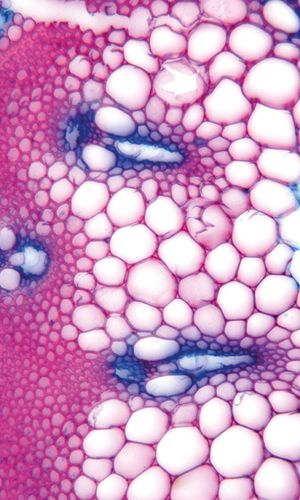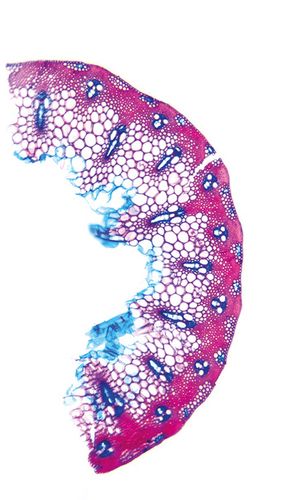Bromus grossus DC.
1007320
Species
ISFS : 65900
Checklist : 1007320
ISFS : 65900
Checklist : 1007320
Contains :
Synthesis
Species description (© Flora Helvetica 2018)
Ähnlich wie B. secalinus, aber Rispenäste behaart, oft etwas überhängend, mit 1-2 Ährchen. Diese ohne die Grannen 1,8-3 cm lang, 10-15blütig. Deckspelzen 9-12 mm lang, etwas länger als die Vorspelze. Grannen 8-14 mm lang.Flowering period (© Flora Helvetica 2018)
6-7Habitat and distribution inside Switzerland (© Flora Helvetica 2018)
Ödland, Getreide / kollin-montan / Vereinzelt CHWorld distribution (© Flora Helvetica 2018)
EurasiatischEcological indicator (© Landolt & al. 2010)
2w43-34+4.t.2n=28Status
IUCN status
Critically endangeredNational Priority
2 - high national priorityInternational responsibility
1 - weakConservation
Threats
Verbesserte Saatgutreinigung, Sortenzüchtung,Ersatz des Dinkels durch ertragreichere Getreidesorten
Intensive Bewirtschaftung (tiefe Bodenbearbeitung, Düngung, Herbizide)
Sukzession in Ruderalgesellschaften, keine Ausweichmöglichkeit
Kleine Zahl der Fundorte
Anatomy
Summary of stem anatomy (German)
Umriss rund oder oval. Leitbündel in mehreren Reihen. Kleine Interzellularen, oft dreieckig. Epidermiszellen verholzt. Chlorenchyma in tangential verlängerten Gruppen.Description
Culm-diameter 2-5 mm, wall large, radius of culm in relation to wall thickness 1:0.5. Outline circular with a smooth surface. Culm-center hollow and surrounded by a few thin-walled, not lignified cells. Epidermis-cells thin-walled all around. Large vascular bundles arranged in 2-3 peripheral rows. Chlorenchyma in round, oval, square or rectangular groups. Sclerenchyma in a large, peripheral continuous belt (> 3 cells). Cells thick-walled. Sclerenchymatic sheath bilateral, large at both radial ends of vascular bundles. Largest vessels in vascular bundles in lateral position. Largest vessel in the bundle 50-100 μm. Cavities (intercellulars) between parenchyma-cells present, small, often triangular. Distinct cavities (intercellulars) in the protoxylem area of vascular bundles.Distribution map
Habitat and distribution inside Switzerland
Vereinzelt CHWorld distribution
EurasiatischEcology
Life form
Therophyte
Habitats
Milieux Phytosuisse (© Prunier et al. 2017)
Habitats © Delarze & al. 2015
 | 8.2.1.1 - Kalkarme Getreideäcker (Aphanion) |
bold
Dominant species, influencing the appearance of the habitat
 Character species
Character species
 Less strictly linked to a specific habitat
Less strictly linked to a specific habitat
Ecological indicator values by © Landolt & al. (2010)
| Soil factors | Climatic factors | Salinity tolerance | |||
|---|---|---|---|---|---|
| Humidity Value H | 2w | Light Value L | 3 | Salinity Index | -- |
| Reaction Value R | 4 | Temperature factor T | 4+ | ||
| Nutriments value N | 3 | Continentality K | 4 | ||
- Ecological values legend
Humidity Value H 1 very dry 1+ dry 2 moderatly dry 2+ moist 3 medium wet 3+ wet 4 very wet 4+ soggy 5 submerged or underwater f plants living in running water u mostly submerged plants v partly submerged, partly floating plants w humidity moderately variable (± scale of 1-2) w+ highly variable humidity (scale exceeding ± 2) Reaction Value R 1 Very acid (pH 2.5-5.5) 2 acid (pH 3.5-6.5) 3 lightly acid to neutral (pH 4.5-7.5) 4 neutral to basic (pH 5.5-8.5) 5 basic (pH 6-5 -> 8.5 Nutriments value N 1 very low in nutrients 2 low in nutriments 3 medium-poor to medium-rich in nutrients 4 rich in nutriments 5 very rich in nutriments Salinity tolerance 1 halotolerant 3 halophyle Light Value L 1 very shady 2 shady 3 lighted areas 4 luminous 5 highly luminous Temperature factor T 1 alpine to nival stages (from the treeline to the snowline) 1+ suprasubalpine and upper subalpine levels (pine and larch forests) 2 subalpine level (coniferous forests without beeches up to the upper limit of spruces) 2+ lower subalpine and upper mountain stages 3 mountain level (beech and silver fir forests, in the central Alps Scots pine forests) 3+ lower mountain and upper hill levels 4 hill level (mixed deciduous oak forests) 4+ hot places, hill level 5 very hot places, hill level (only in the hottest places, typical of southern Europe) Continentality K 1 Atlantic (high air humidity, very low temperature variations, mild winters) 2 Sub-Atlantic (high air humidity, low temperature variations, relatively mild winters) 3 sub-Atlantic to subcontinental (average air humidity, moderately variable temperature, slightly low winter temperatures) 4 subcontinental (low air humidity, large temperature variations, rather cold winters) 5 continental (very low air humidity, very large temperature variations, cold winters)
Water dependency
| Rivers | 0 - No link |
| Calm water | 0 - No link |
| Ground water | 0 - No link |
Nomenclature
Accepted Name (Checklist 2017)
Bromus grossus DC.
Vernacular name
Deutscher Name :
Dicke TrespeNom français :
Brome à gros épilletsNome italiano :
Forasacco del farroMatch with other reference books
| Relation | Nom | Book | No |
|---|---|---|---|
| = | Bromus grossus DC. | Checklist 2017 | 65900 |
| = | Bromus grossus DC. | Flora Helvetica 2001 | 2610 |
| = | Bromus grossus DC. | Flora Helvetica 2012 | 2786 |
| = | Bromus grossus DC. | Flora Helvetica 2018 | 2786 |
| = | Bromus grossus DC. | Index synonymique 1996 | 65900 |
| = | Bromus grossus DC. | Landolt 1977 | 373 |
| = | Bromus grossus DC. | Landolt 1991 | 335 |
| = | Bromus grossus DC. | SISF/ISFS 2 | 65900 |
| = | Bromus grossus DC. | Welten & Sutter 1982 | 2257 |
= The taxon corresponds to the accepted taxon (Checklist 2017)
< The taxon is included in the accepted taxon (Checklist 2017)
> The taxon includes (among others) also the accepted taxon (Checklist 2017)
< The taxon is included in the accepted taxon (Checklist 2017)
> The taxon includes (among others) also the accepted taxon (Checklist 2017)
Status
Native status
-IUCN list of endangered species (© Walter & Gillett 1997) : Yes
Status on national Red List 2016
IUCN status:
Critically endangered

Additional information
IUCN criteria: C2a(i)
Status on regional Red List 2019
| Biogregraphic regions | Status | IUCN criteria |
|---|---|---|
| Jura (JU) | CR(PE) | |
| Mittelland (MP) | CR | C2a(i) |
| Alpennordflanke (NA) | CR(PE) | |
| Alpensüdflanke (SA) | RE | |
| Östliche Zentralalpen (EA) | RE | |
| Westliche Zentralalpen (WA) | RE |
- Legend
EX Extinct RE Regionally Extinct CR(PE) Critically Endangered, Probably Extinct CR Critically Endangered EN Endangered VU Vulnerable NT Near Threatened LC Least Concern DD Data Deficient NE Not Evaluated NA Not Applicable
National Priority Species List Status
| National Priority | 2 - high national priority |
| Need to take action | 2 - |
| International responsibility | 1 - weak |
| Need to monitor populations | 1 - |
Protection status
| International (Bern Convention) | Yes | |
| NW | total protection | (29.11.2005) |
| SH | total protection | (06.03.1979) |
| Switzerland | -- | |
| VD | total protection | (02.03.2005) |
| TI | total protection | (23.01.2013) |
- Disclaimer
InfoFlora compiles information on protected species as accurately as possible, taking it from the respective cantonal laws. In some cases, however, it was not possible to use the plant names as listed in the original text, but an interpretation of their taxonomy or nomenclature was necessary. The exact meaning of the categories „completely protected“ and „partially protected“ differs among the cantons.
InfoFlora cannot guarantee that the information on the protection status is correct and complete. In case of doubts, we recommend to look up the texts of the respective cantonal law.
Status by sector of activity
| Agriculture-related environmental objectives : | Z - | more informations |
| Forest management environmental objectives : | more informations |
Conservation
Threats and measures
Verbesserte Saatgutreinigung, Sortenzüchtung,Ersatz des Dinkels durch ertragreichere Getreidesorten
Extensive (Dinkel-) Getreideäcker in thermisch günstigen Lagen im früheren Anbaugebiet des Dinkels anlegen oder fördern (z. B. im Rahmen der Erhaltung alter Getreidesorten, auf Grenzertragsflächen)
Verzicht auf perfekte Saatgutreinigung
Intensive Bewirtschaftung (tiefe Bodenbearbeitung, Düngung, Herbizide)
Nur geringe, wenig tiefe mechanische Bodenbearbeitung
keine oder geringe Düngung
dosierter Herbizideinsatz nur im Extremfall
Sukzession in Ruderalgesellschaften, keine Ausweichmöglichkeit
Genügend grosse Ruderalflächen (mit unterschiedlicher Störungsintensität) in Industriegebieten zulassen
klare Zielvorgaben und Beratung von Firmen mit solchen Bereichen
Kleine Zahl der Fundorte
Schaffung weiterer günstiger Ersatzlebensräume z. B. entlang von Bahnlinien
Information der Bevölkerung über den Zweck von «ungepflegten» Flächen
sofern noch Fundstellen bestätigt werden: ex-situ-Kultur für Erhaltungskulturen und allfällige spätere Wiederansiedlungen
Erfolgskontrolle der Massnahmen gewährleisten
für vollständigen Schutz vorgeschlagen (NHV, z. Z. in Revision)


